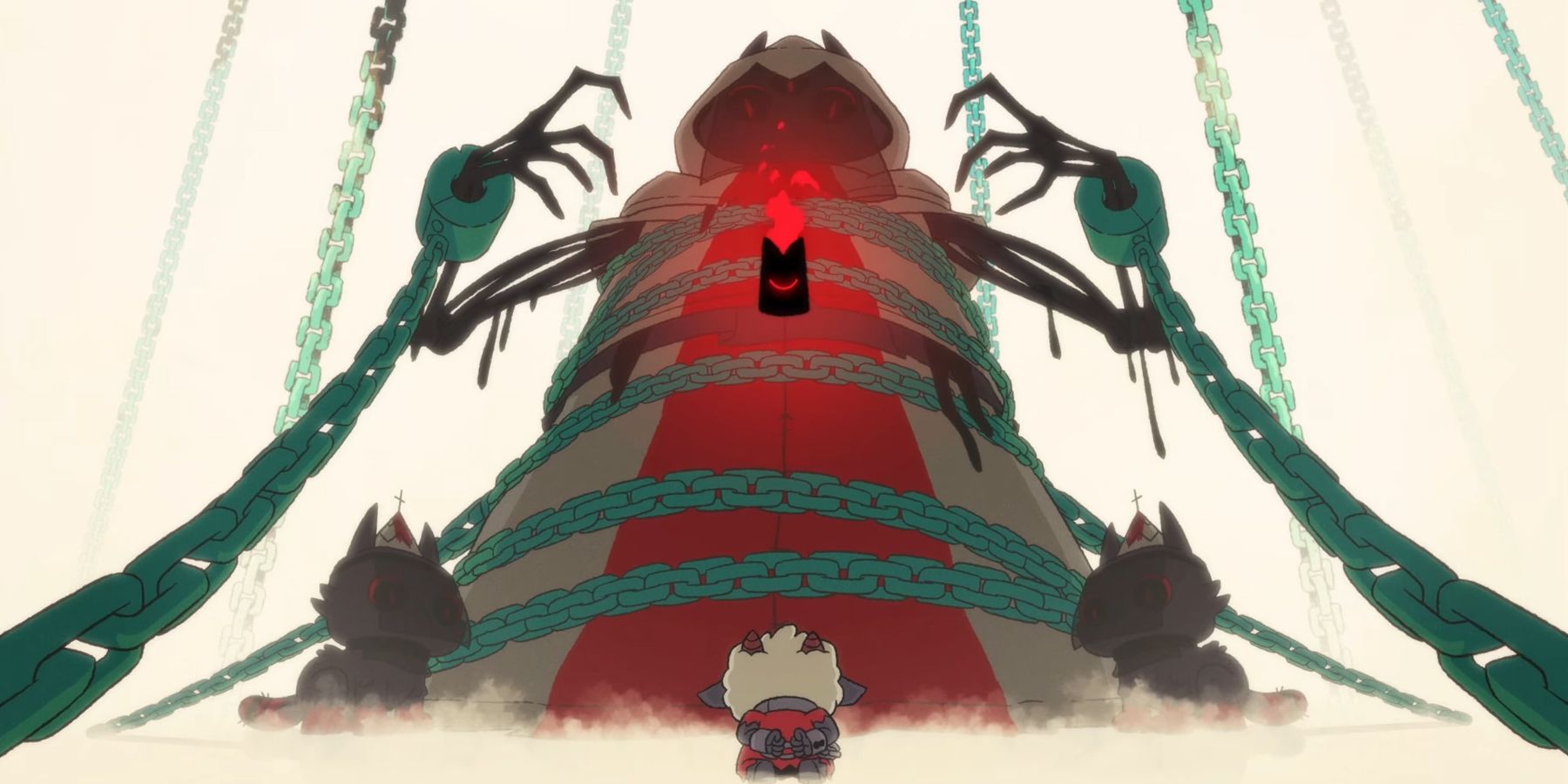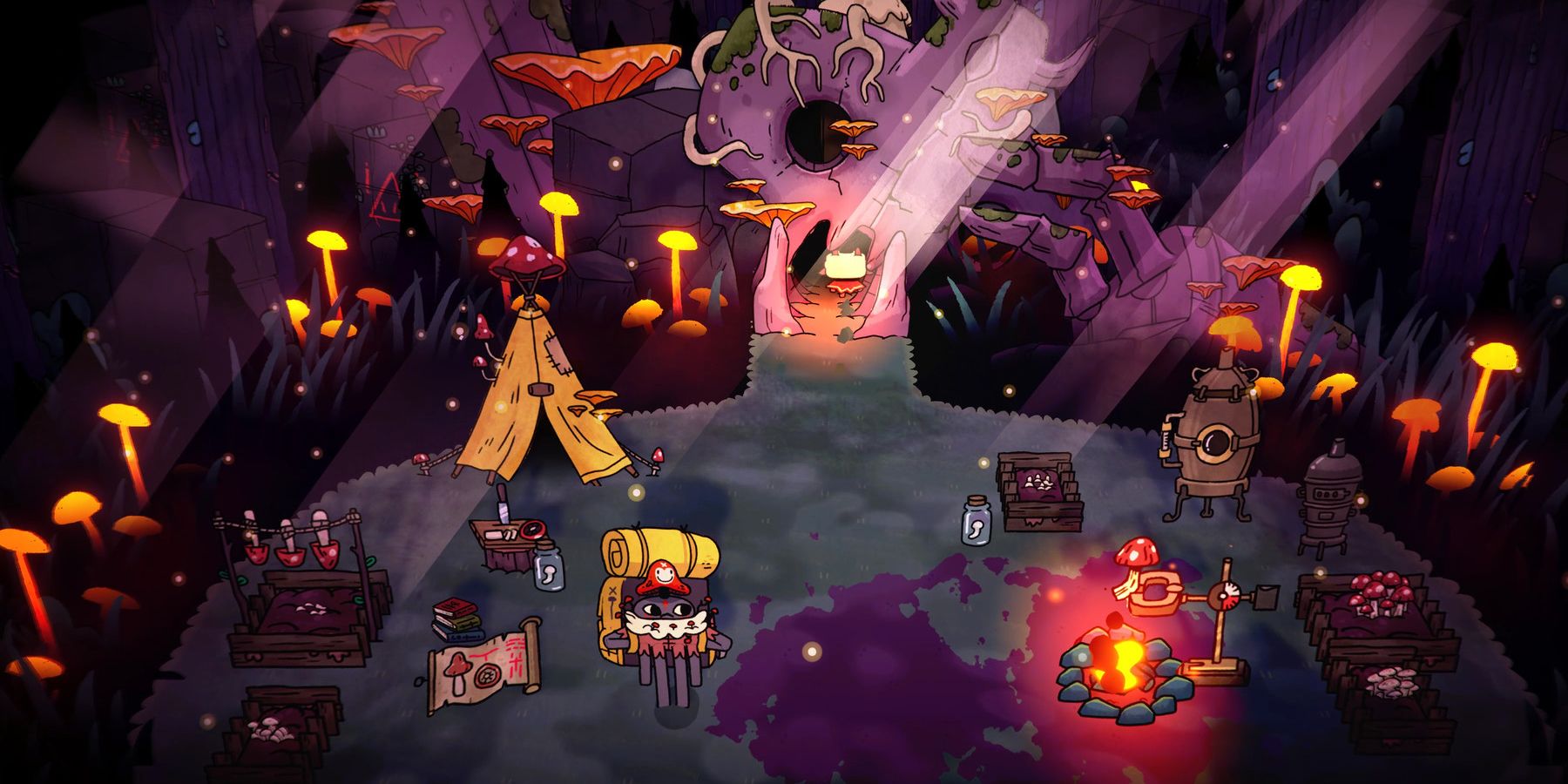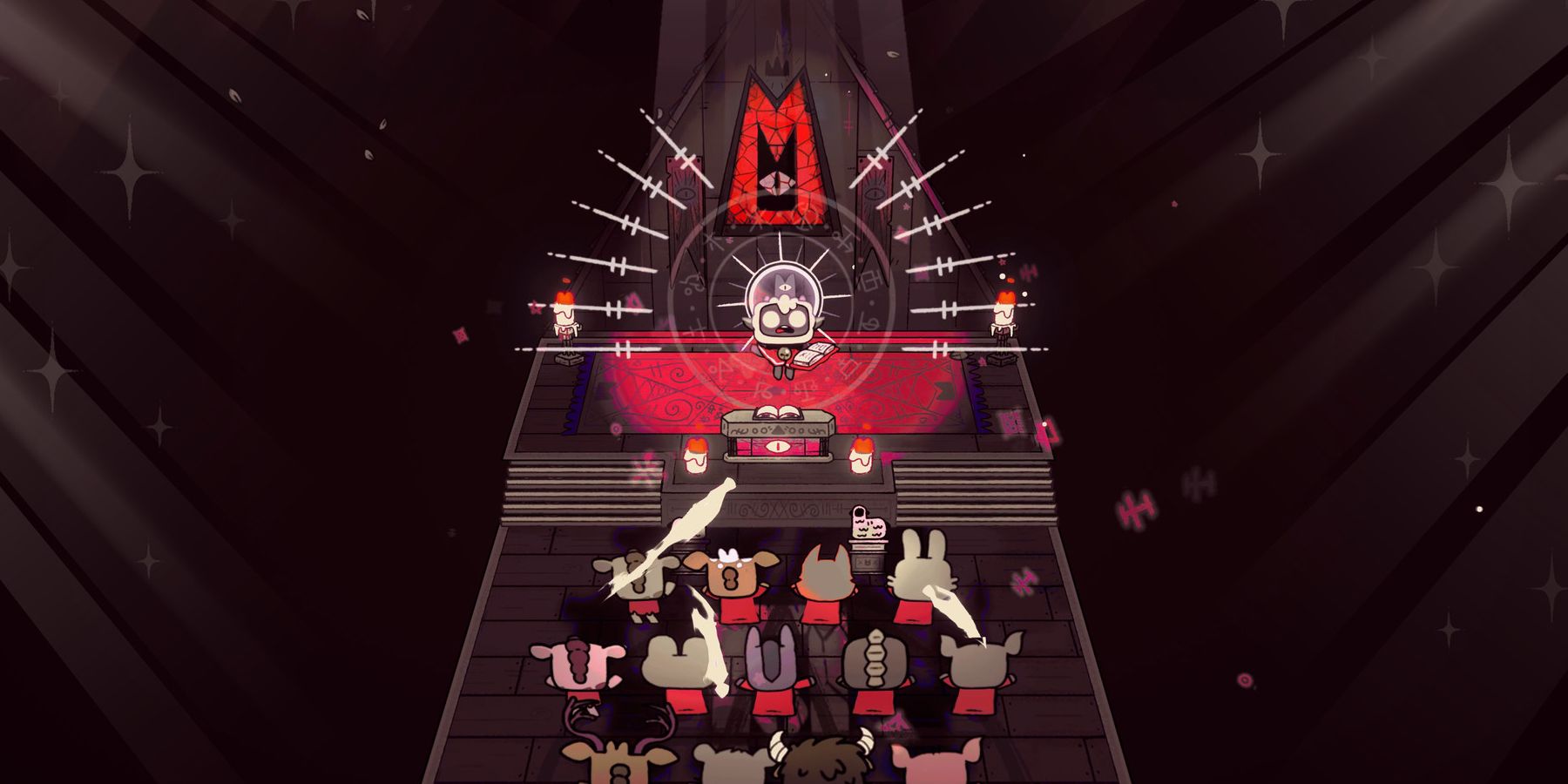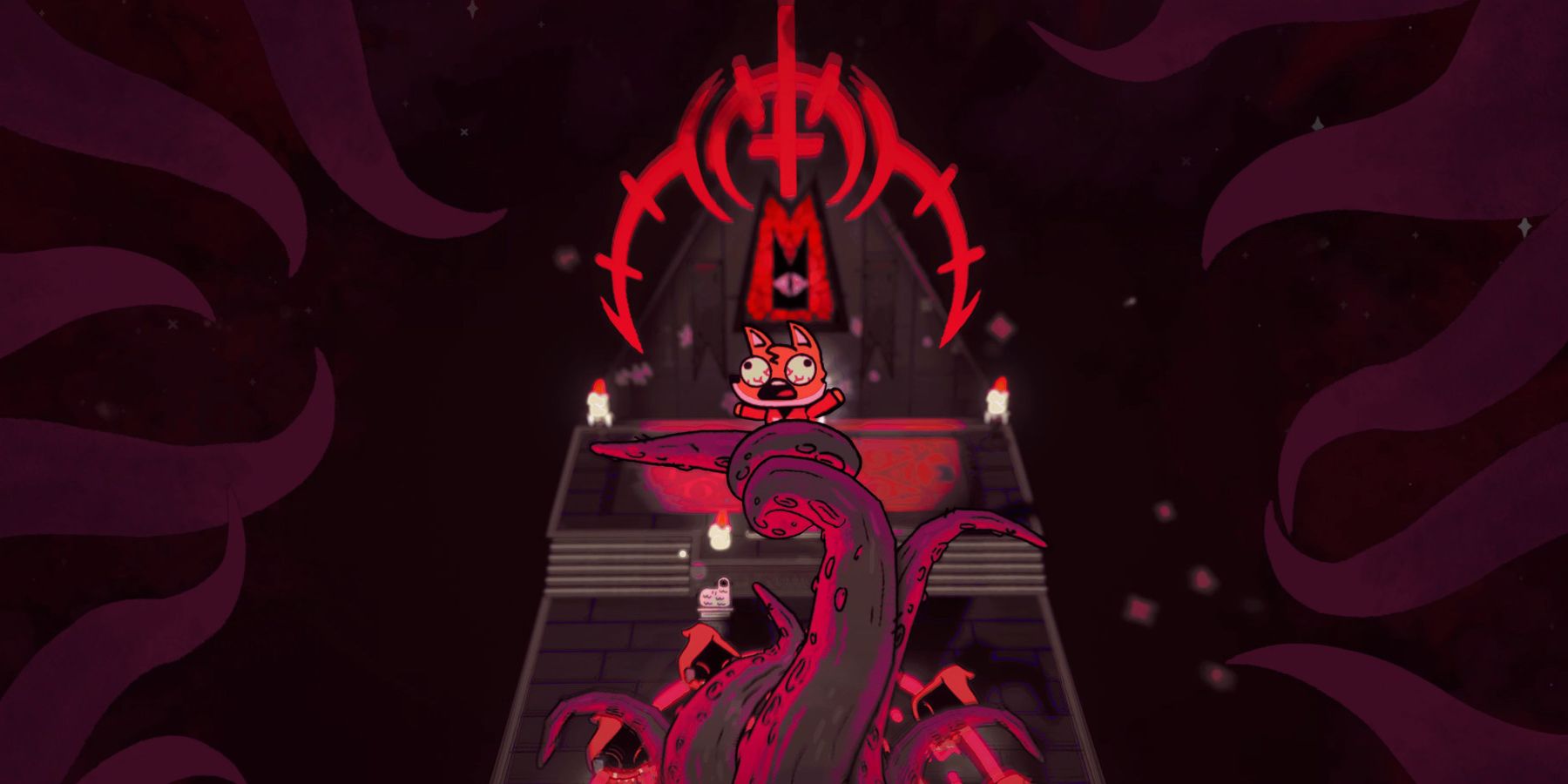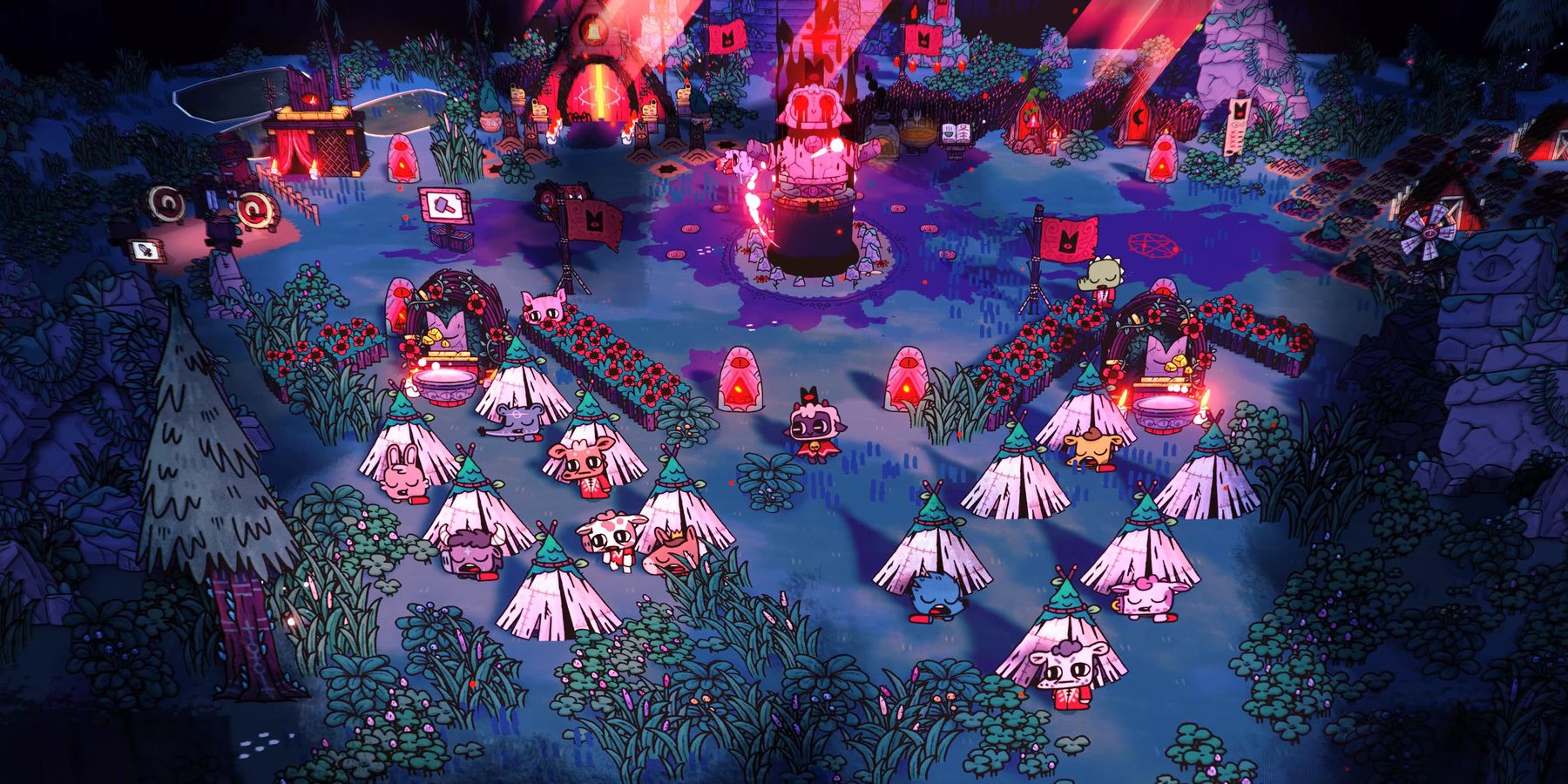Summer 2021 has revealed a lot of new games. From E3 to Gamescom, fans have had their calendars filled with events and announcements from AAA studios and indie developers alike. A crowd favorite coming out of Gamescom has been Cult of the Lamb, a new title being published by Devolver Digital next year. Its art style and themes continue to attract a growing number of fans as Massive Monster gets ready for Cult of the Lamb’s 2022 release.
Game Rant spoke with design director Jay Armstrong and creative director Julian Wilton from Massive Monster about their experiences working on Cult of the Lamb and what has inspired them. Interview has been edited for clarity and brevity.
Q: To start what was the timeline like for Cult of the Lamb’s Development?
Wilton: Good question, getting straight into it. Love it. We probably had a prototype floating around, I don’t know, what was it three years ago?
Armstrong: Three years ago. Yeah, we shared it at a PAX Australia and I think that’s when we had it. It was a really rough prototype but we were still finishing up a bunch of other projects. It was a long time before we were ready to really start on it. It didn’t have the cult theme at all.
Armstrong: Yeah! That kind of came in a bit later. The original concept was having a game like RimWorld or Frostpunk or something like that, but taking on the role of one of the characters in that colony. Going out and having an adventure and scavenging resources to bring back for the rest of the colony. That was the original idea, but it was really hard to explain it to people. Like I just explained it to you very poorly. It was “Ok you do this you do that.” and it’s very hard to get that across which is where Julian stepped in with this idea of “No, we must have a core concept that unites it.”
Wilton: You know we say that but we went through two or three different other ideas. It was like you were God and you were going to eat your followers or something. That wasn’t really working. So, we tried out maybe it's like you’re running a Hell. Maybe you’re a kind of demon guy running a Hell. But we just found we like looking after the followers. When we had to make a building to torture them, we were like “Hmm, I don’t know- I don’t know about this.”
Armstrong: Too cute.
Wilton: Yeah, yeah. Exactly. You know I really love occult stuff and cults. I was probably just watching Midsommar or some stuff like that, and then we kind of started on the cult idea. All the dots were connecting and we thought “Yeah it’s quite a unique kind of fantasy that players can experience.” So, we thought yeah “Let’s bloody try to get it going.” Then I think we started getting that together a little bit. We put together a little pitch to Film Victoria for some funding, it was a small grant to get to a vertical slice. We were working on that for maybe like six months and then started to pitch to publishers, got a deal last year in April, and been working on it since.
Q: I saw the Film Victoria grant online when I was going through your [Massive Monster’s] blog, which I thought was awesome. That is fantastic.
Wilton: Yeah. I was a bit like “Oh, I wonder if the government wants to fund this game about like Devil worship.” or whatever. But they’re chill with it so here we are.
Armstrong: Government-approved sacrifice.
Q: After the reveal at Gamescom, what are Massive Monster’s plans going forward?
Wilton: Ooh, well, finish the game.
Armstrong: Yeah. I was going to say the same thing.
Wilton: It’s kind of weird because we haven’t really worked on a game where there’s actually a bit of hype behind it before. With our other games, there were definitely some people excited for them, but it wasn’t that many. Now there’s heaps of people and our Discord’s getting flooded a bit. I feel like there is this pressure to make sure that we’re meeting the expectations that people think the game is. We’re very excited that people are into it.
Armstrong: And we can listen to what people are saying. We’ve got this vision of what we’re going to make but we can also then listen to people as well, which is something we haven’t been able to do. Kind of take on and make sure that we’re going in a direction that we think we want to be in but that other people are excited about. It’s very interesting to see reflected back on us. Like what are the things that people are excited about? Because of COVID, this whole game has been done in essentially lockdown, in secret, and we haven’t been able to show it. We always used to show our games at every show we could do. We would show people and see what they like. “Oh, that’s great.” or “We could tweak that.” or “That looks a bit hard.” We haven’t been able to do that at all and that’s made it very difficult. So now to actually, after two years or whatever, see what people respond to is just so exciting. We can make sure that we’re addressing everything that we think people are excited about.
Q: That sounds a lot different though. With the pandemic and not being able to do conventions. That’s a very different way to go when you’re used to being able to show everyone what you’ve been working on, and now you’re in that situation [lock down].
Wilton: Yeah definitely. That’s kind of why we showed the demo at PAX two years ago. Whenever it was. Just because we’re like “What are people actually interested in in this game?” I think from there we kind of figured out “Oh they really like the followers and stuff like that. So, let’s just kind of make sure the game’s kind of just about that.” I’ve been loving some of the stuff that’s like “Animal Crossing meets Doom.” and stuff like that. We’re like “Alright. That’s cool.” We can kind of go in these directions now which is nice.
Q: I read that you guys are using random generation in the creation of the world, but there’s also a focus on hand-drawn art. What were the challenges coming into that? How did you keep your hand-drawn art style intact while also working with the random generation of each world that the players are going to be going through?
Armstrong: With the random generation it’s primarily the followers that are randomly generated. So, they have different animals, they have different traits which affect what they do like and what they don’t like, and if you behave a certain way that will lower their faith or raise their faith more. They kind of each provide a little bit of a tweak to the challenge. But also, the main bit of the [random] generation is the dungeon crawling side of the game. It’s very much like a Binding of Isaac style, room-to-room, dungeon structure that’s procedurally generated. Each room draws from a big pool of randomized encounters that we’ve created.
But one of the interesting things, as you say, is that we’re trying to have this narrative structure to the game while still allowing you to have a sandbox-y kind of freedom to it. That’s definitely been a real challenge. That’s kind of where the procedural generation is. The world itself, the overworld, the map itself, will always be the same; but the combat side of it, the dungeon crawling side of it, that’s where the procedural generation really shines. And of course, the art style. The sort of 2D 3D thing has been an interesting challenge for the art side as well.
Wilton: Yeah. All our other games are, flat, side-scroller, platformers really. So, it was very different going to the 3D. I think trying to get that hand-drawn look into the levels. We have all these different biomes, and layers, and we introduce new scenery prefabs. All the world’s kind of made up of these little chunks of decorations. I think we go there with that. But the idea’s to give every level we can a bit of love with hand-drawn stuff or custom stuff. I think that’s kind of how we achieve that balance.
Q: What kind of things with that [procedural generation] are you interested in players discovering throughout the world; inside the dungeons?
Wilton: Story elements. We actually don’t have too many yet be we definitely want to have all these little secret things you can do and things the players will miss the first time playing. But after they’ve played for ages, they’ve kind of picked up on these clues and discovered these things. We have gotten quite a few systems where we can unlock content. We have these tarot cards that give the player buffs and the followers’ skins, and quite a few other things. So, we can let the player explore and find these rare collectibles and stuff through those systems. Which will be good.
Q: Do you have anything you want to add Jay?
Armstrong: Yeah! I was trying to think of something that actually adds value because I think Julian covered it. When you’re out in the dungeon crawling side of it when you complete a floor of the dungeon, you’re brought up to this map which then allows you to go in and pick a direction. And it can be specific. This direction might be where the lumber is, and this direction is where the stone is, or this direction is a combat challenge. So you can pick your own route. I’m really excited to see people have little, mini, bite-sized adventures whenever they go out. That’s where we can also place enemy cult leaders for you to encounter and for them to move the story forward but also maybe give you a combat challenge. I’m really interested to see all these pieces come together.
Q: That reminds me a lot of the path choices with Hades. Which came out last year, was it like last November?
Wilton: Yeah, I think so.
Armstrong: I haven’t seen that actually. We’re taking more inspiration from Slay the Spire.
Wilton: We just stole it from Slay the Spire. Yeah, there ya go.
Armstrong: Shh.
Wilton: I think with the idea being that we kind of want every run you take to be a bit different. Which has been quite a struggle because we’re basically making two games in one. It’s hard to make sure we’re allocating enough resources on each side to make sure each side is feeling good. But then that also follows through with the base. If you were to play it multiple times, we want it to feel different every time because you can have different problems with followers. There can be these emergent stories just based on what’s happened. If someone starved and dies you can harvest their meat and feed it to the other followers but then they might get sick from that. There’s just a progression of things that can happen. Should be good.
Q: There are some moments from the Gamescom reveal video that suggests deeper gameplay. A couple of scenes stood out to me. There’s one that seems to show the direct sacrifice of a cult member to a tentacled god, and then the transition right at the end gave a lot of necromancy vibes. Implying that you might be raising dead cult members. In what ways should players expect these things to affect gameplay? Or should they expect these things to affect gameplay?
Armstrong: They should, they should. They definitely should. I think we’re trying to offer a way for you to create your own cult to some extent. We’ve been trying very hard to give you options of unlocking dark ritualistic sacrifice or maybe more of a happy, flower-powery kind of direction with your cult. But it’s difficult because the dark stuff is so much more fun that we keep leaning into the dark stuff. Because, I think, that’s what’s more interesting about this game.
But certainly, you will unlock rituals; dark rituals that you can perform with or on your cult members. That’s a big part of the game. Preaching sermons that help brainwash your followers and teach them certain beliefs. You can teach them either to believe in the afterlife so that when they see a dead body they’re happy, they’re no longer sad. Or you can teach them to embrace sacrifice. So, when you do sacrifice someone at the beginning of the game people are going to be upset and kind of “Oh, I’m a bit uncomfortable.” but once you’ve taught them the belief that sacrifice is the way they want to go you can pick those two directions.
We’re also hoping that when you go back and play, if you play again, you go “Oh wow I missed out on that, I really want to see that.” So, you can play the game again and unlock those things and take a different path with your cult. Those things are definitely there and those are things we want to give the player the tools to kind of explore their dark tendencies.
Q: See how far down the rabbity hole people are willing to go?
Armstrong: What kind of monster are you really? That’s what this game’s really about.
Wilton: Yeah, so you’ve got your rituals and you’ve got your sermons. With the rituals, you get a bit of progression on the player. Just through doing this ritual you basically can choose to get more health or be a bit stronger but it requires a certain amount of followers. One of the core loops I would say is getting more followers so you can do these new rituals that will make you stronger. Getting stronger through your cult is the idea behind it.
Q: The cult is essentially what’s going to supply your skill tree throughout the game?
Armstrong: Exactly yes. For both sides of the game. You unlock new buildings by the shrine in the center of the game. The worshippers pray into that, you draw out the devotion from that, and that unlocks new buildings. Then the rituals side of it is often to make you stronger for the dungeon-crawling side.
Q: What inspired Cult of the Lamb’s style? I know you guys mentioned The Binding of Isaac and there have been the Doom and Animal Crossing comparisons that people have done. I get very much an Animal Crossing and Paper Mario feel from the art design but the darkness of the world itself is definitely like The Binding of Isaac for me.
Wilton: Yeah, I really love horror films and kind of occult and dark stuff. You know the first big game I worked on was the Adventure Pals which was very Adventure Time-y with its style. Very cute and random. And after that, I was just like “I kind of want to do something a bit darker.” But I think it’s impossible for me to not draw cute stuff still. So, I was still going back to those cute things, but it kind of works like a nice juxtaposition. It makes the darker stuff feel a lot darker because the neutral stuff at the base is a bit more happy and cute.
Then that also juxtaposes with the dungeon which, again, is very dark and there’ll be messed up sh*t in there. I think I was also inspired by some TV shows like Over the Garden Wall, this cartoon show. Midsommar, Hereditary, and stuff. But Over the Garden Wall looks a bit cute on its surface but has this really deep, deep layer of darkness to it and you’re like “Woah.” and I thought that’d be cool to apply into a game.
Q: Jay do you feel there are any inspirations that you drew on in the development process at all?
Armstrong: Cause I’m more on the programming side of it and the gameplay side of it I would just say that Julian and James have done a phenomenal job. It’s really exciting for me because I get up in the morning and see this incredible artwork that’s been done and it’s really inspiring and helps me feel motivated as well. Working with these talented people I feel very lucky.
Wilton: Oh, stop it.
Q: The flattery. When you mention it, the Over the Garden Wall stuff I pick up on, because as you said, the juxtaposition of cute and horror is very much there.
Wilton: Yeah. It’s very tasteful in the way it’s done. I’ve seen a few people saying, “Oh like Happy Tree Friends.” But that’s kind of like f*cked up for the sake of being f*cked up where Over the Garden Wall it’s all within a story, its own world.
Q: I feel like we kind of answered this next question already but to pull a little more out of you guys; are there any key inspirations outside of games that Cult of the Lamb has?
Wilton: Jay do you have any you want to talk about? Originally, I guess we were trying to incorporate Jay’s degree he has on some level.
Armstrong: Yeah. Originally, we had this idea of competing cults. I have a Master’s in Geopolitics so the idea was we were making this geopolitical situation where you were trying to vie for more territory. The problem with that was we had so many things in the game because as Julian already said, this is not two halves of the game this is like two games.
So, trying to have a third one just didn’t work. We were trying to include so much. We had done so much iterating with this game. It’s been through so many different phases and it's really fun because I’ve kept a lot of the old footage from the original and different phases that we’ve been in. It’s funny to see all the kinds of things that we thought were a good idea at the time but we realized weren’t. There’s been a lot of iteration. There was a really cheesy sci-fi book that kind of gave me the original concept, which was about the world had ended and all the remaining people lived up on this blimp. They went around the Earth and on the ground were these mutants and things. But they couldn’t live on the blimp they had to go down and try and scavenge for food and that’s when combat would happen.
Once they got enough, they could go back up and I just thought that was such a cool idea. We were talking earlier about the prototype, that’s kind of where the original idea came from; being responsible for this group of people and going out and risking your life for them to come back and keep things going. That was one of the inspirations for me but I’m not sure how helpful that is.
Q: It’s nice because I think as players sometimes, we forget that there are these long processes that you go through when developing a game, so acknowledging the iterations that something like this can go through is awesome. Let people know “Hey we started with three, we came down to two, and now we’ve fleshed these out.”
Q: If you had to pick a target audience and their best reaction to the game, in your mind what would those be for Cult of the Lamb?
Wilton: I kind of like the Animal Crossing fans because they come from these very wholesome games and stuff like that. They’re going to be thrown into having these problems and having to deal with them in weird ways. Their followers dying or their followers being naughty or uprising against them. I think they’re kind of “Aw cute little bunny” or whatever and they jump in and are like “Oh my god. I’m going to have to kill the bunny.” I think that’s what I’m interested in.
Armstrong: Yeah, that sounds great. Me too. I’m looking forward to all the people going in looking forward to the cute animals and having their expectations really subverted. But I hope that they still find a really fun game anyway and so they’re kind of angry at themselves for all the horrible things they’re doing but they just can’t stop playing because it’s so fun. That’s what I hope.
Wilton: Yeah, and hopefully we can ease those players into more of a dungeon crawling rogue-like type experience with the dungeon because it might be something where they haven’t really tried too many before. It’s going to be difficult on our end to try and make sure we’re catering to that audience and then also the audience that loves Hades and all those games and want a hard challenge. It’s going to be an interesting mix.
Armstrong: We’re definitely feeling the concern or the pressure of having two games, two sets of audiences. But we’re making sure that everyone can come together, and everyone can be happy.
Q: Before we finish up is there anything you would like to touch on that you feel we missed in the conversation?
Wilton: I’m not too sure. We covered quite a lot of things. I don’t know if I ever said but I’m the Creative Director. I do more of the art, drawing faces on things. Jay’s kind of mainly programming and core game design stuff as well. We have this, as we were saying, a big overall story we’re trying to achieve. But then might turn it into more of a sandbox thing after you’ve finished it. Thinking maybe this is kind of like, what were you saying Jay the other day?
Armstrong: The origin story.
Wilton: Yeah, the origin story. And we have plans. We’re going to make sure we’re releasing it for at least a year after it’s developed as well, or after its release. We’re going to make sure to support it. That way if people have any feedback we can try and incorporate it once it’s out.
Q: So, there is a post-release plan? A solid roadmap of “Hey we want to do this over the next year.”
Wilton: Yeah, we’re already kind of planning those out at the moment, which is exciting.
Armstrong: We’re really excited. The potential of the game’s structure means we can add more dungeon crawling, more building structures, and just kind of react to how people respond to the game and see what people are enjoying. Inevitably everything won’t be perfect so seeing what parts we can improve and what parts we can build on. We’re really looking forward to doing that with people who enjoy the game.
[END]
Cult of the Lamb releases in 2022 for PC.

